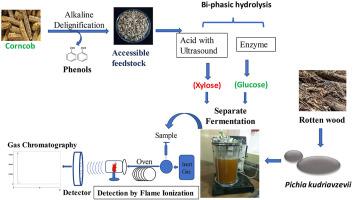Biomass & Bioenergy ( IF 5.8 ) Pub Date : 2021-08-19 , DOI: 10.1016/j.biombioe.2021.106230 Bindu Sunkar 1 , Bhima Bhukya 1

|
In order to have sustainable energy and to reduce the reliance on fossil fuels, transition to renewable bioenergy is highly desired. Adequate biomass conversion to ethanol requires total carbohydrate extraction from the feedstock with minimum inhibitors. The present study aimed at revealing the fermentation potential of toxin resistant and thermotolerant Pichia kudriavzevii for ethanol production. Corncobs being one of the most abundant renewable biomass, was chosen for sequential bioconversion process to ethanol. Firstly, the biomass was pretreated using 2% NaOH which resulted in 83.12 ± 1.07% delignification. Subsequently biomass was used for biphasic hydrolysis (ultrasound assisted dilute acid followed by enzyme) which resulted in 27.03 ± 0.91 gL-1 of xylose, 0.33 ± 0.03 gL-1 furans in the first phase and 27.33 ± 0.9 gL-1 glucose in the later phase. Fermentation efficiency of P. kudriavzevii was evaluated using enzyme and acid hydrolysates (detoxified and undetoxified) which resulted in 11.98 gL-1 ethanol with glucose, 3.83 gL-1 and 3.64 gL-1 ethanol with detoxified and undetoxified acid hydrolysates with theoretical yield of 85.95, 31.89% and 28% respectively at 42 °C. Though the efficiency with xylose was low, the strain was found to be one among very few Pichia strains that have ability to ferment xylose. Furthermore, developing a potential biological process that utilizes the renewable biomass for energy development will not only save a lot of foreign exchange, but also helps in waste management in a sensible way.
中文翻译:

使用抗抑制剂和耐热酵母 Pichia kudriavzevii 双相水解玉米芯提取总糖和生产乙醇
为了拥有可持续能源并减少对化石燃料的依赖,非常需要向可再生生物能源过渡。充分的生物质转化为乙醇需要用最少的抑制剂从原料中提取总碳水化合物。本研究旨在揭示抗毒素和耐热毕赤酵母用于乙醇生产的发酵潜力。玉米芯是最丰富的可再生生物质之一,被选为乙醇的连续生物转化过程。首先,使用 2% NaOH 对生物质进行预处理,导致 83.12 ± 1.07% 的脱木素。随后将生物质用于双相水解(超声辅助稀酸,然后是酶),产生 27.03 ± 0.91 gL -1的木糖,0.33 ± 0.03 gL-1呋喃在第一阶段和 27.33 ± 0.9 gL -1葡萄糖在后期。P. kudriavzevii 的发酵效率使用酶和酸水解产物(解毒和未解毒)进行评估,结果产生 11.98 gL -1乙醇和葡萄糖,3.83 gL -1和 3.64 gL -1乙醇和解毒和未解毒酸水解产物,理论产率为 95。在 42 °C 时分别为 31.89% 和 28%。虽然木糖的效率很低,但发现该菌株是极少数毕赤酵母中的一种具有发酵木糖能力的菌株。此外,开发利用可再生生物质进行能源开发的潜在生物工艺,不仅可以节省大量外汇,还有助于以合理的方式进行废物管理。











































 京公网安备 11010802027423号
京公网安备 11010802027423号